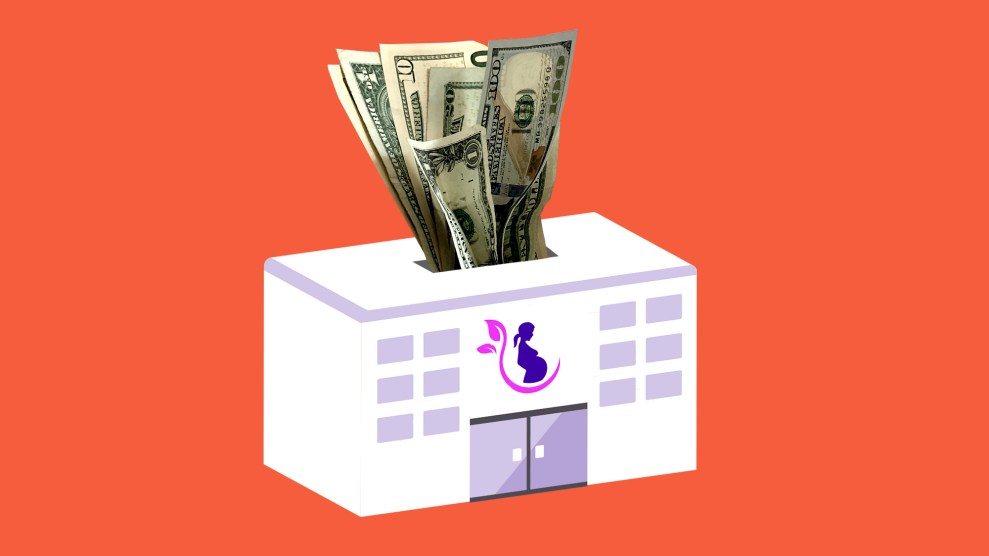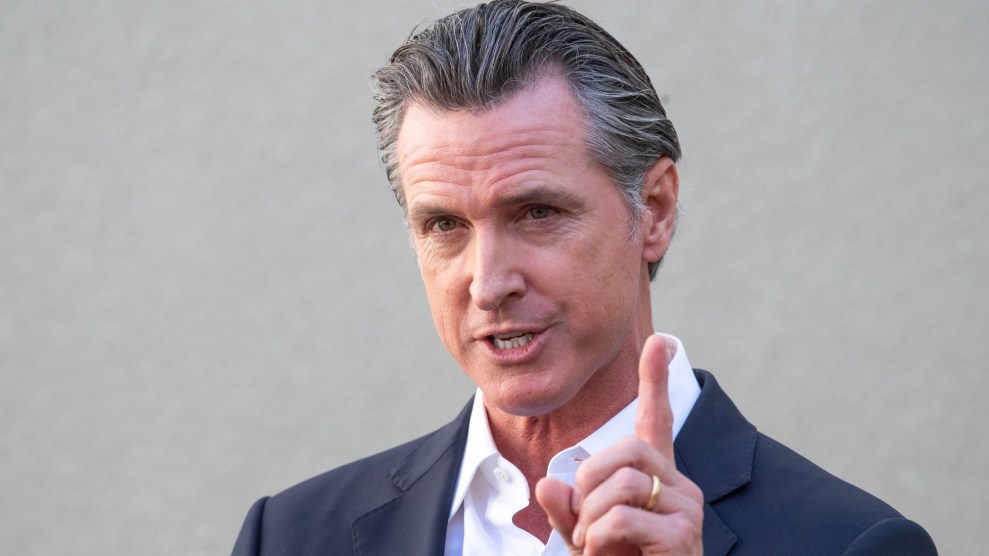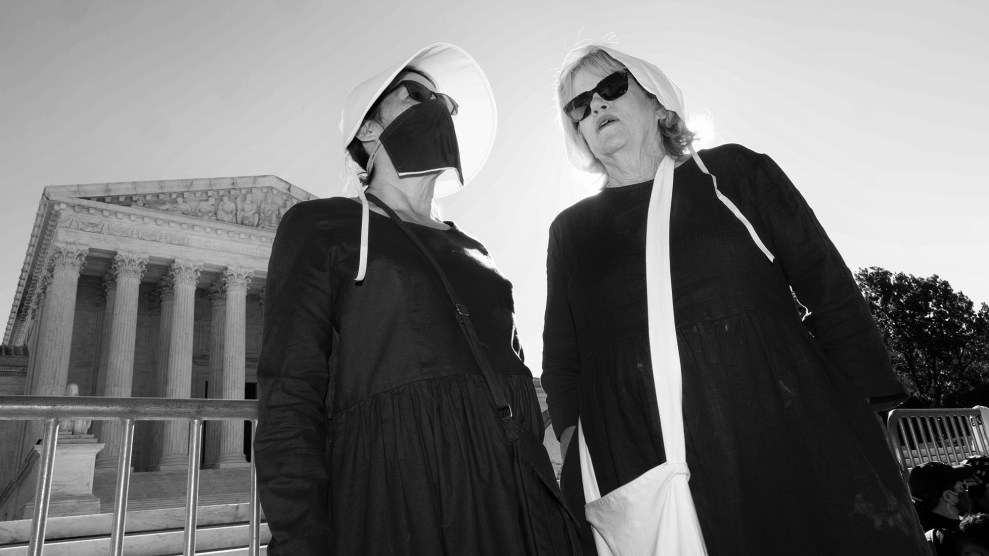
Mother Jones illustration; Getty; Unsplash
This article was originally published by Public Health Watch, a nonprofit investigative news outlet.
After finding out she was pregnant last fall, B.Z. made an appointment at a Texas crisis pregnancy center, believing she could obtain a medical consultation.
Time was of the essence. A state law that took effect Sept. 1 barred abortions past any detection of embryonic cardiac activity, which is typically as early as six weeks of pregnancy, with no exception for rape or incest.
The pregnancy center’s staff told B.Z. she needed a sonogram but said it couldn’t be performed for one week. They failed to disclose that the delay might make her ineligible for an abortion under Senate Bill 8. While state law requires abortion-seeking patients to obtain an ultrasound 24 hours prior to the procedure—one of myriad barriers to care in Texas—the non-diagnostic sonograms performed at centers such as the one B.Z. visited do not qualify. The state mandates that the ultrasounds be diagnostic and performed by the doctor who will also complete the abortion.
During her second appointment at the pregnancy center, B.Z., who asked that her name remain confidential, was now exactly six weeks pregnant—on the cusp of SB 8’s gestation cutoff—and suffering from “extreme” morning sickness, according to an October court filing by Planned Parenthood.
“[The staff member] didn’t care if I wanted to or could have a baby,” B.Z. said in the filing. “She wasn’t even worried about how I was so sick.”
B.Z. was soon diagnosed with severe pregnancy-related nausea at an emergency room. The doctor informed her that she could be a facing a “difficult pregnancy,” but that going out of state was her only option if she wanted an abortion. The travel and procedure cost her $800, paid out-of-pocket to “maintain her privacy from family members on her insurance plan,” according to the Planned Parenthood filing. B.Z. missed nearly two weeks of work due to illness from the pregnancy.
“It was nerve-wracking. How am I going to handle the drive? Can I make it there without throwing up in the car?” she recalled thinking. “What happens if something goes wrong in a state I’ve never been to, with my mom so far away?”
The crisis pregnancy center, or CPC, she visited pushed her too far into her pregnancy to receive care in her home state. It was a strategy that fell in line with the mission of CPCs—largely non-medical, faith-based facilities whose central mission is to dissuade pregnant people from obtaining abortions.
As Texas abortion clinics have dwindled over the years due to increasingly restrictive state laws—from around 40 before 2013 to 20 today—CPCs have proliferated. There are now nearly 200 of them in Texas—the most in any state—including about 60 that receive taxpayer funds and are not regulated by the state health commission. In the United States overall, CPCs outnumber abortion clinics three to one.
State funding for Texas CPCs increased twentyfold, from $5 million to $100 million per biennium, between 2006 and 2021. Money has been diverted from state and federal programs to support them. A Public Health Watch review of documents obtained under state open-records requests found that CPCs dominate the state’s massive investment in the Alternatives to Abortion (A2A) program, which seeks to provide support services to pregnant women and their families.
“CPCs exist to manipulate and shame people out of choosing abortion care—and the state not only encourages this, but facilitates it,” said Emily Martin, deputy director of Avow Texas, a reproductive-rights advocacy group.
As local and national investigations have shown, CPCs often use medical disinformation, religious proselytizing, intentional delays, shame, and false advertising to achieve that goal.
“From the years of research we have done into CPCs in Texas, it’s clear a major tactic is luring people through the door and confusing them with medical lies and fear in order to delay or prevent abortion access,” Martin said.
Health care inaccuracies perpetuated at Texas CPCs include an erroneous link between abortion and breast cancer as well as the debunked “post-abortion stress syndrome” —a condition not recognized by major medical and psychological associations, Martin said.
CPCs, which often pose as legitimate clinics, have been rebuked by the mainstream medical community: Although the centers enjoy First Amendment protections, their “propagation of misinformation” should be regarded as an “ethical violation that undermines women’s health,” Dr. Amy Bryant wrote in the American Medical Association’s Journal of Ethics in 2018.
Supporters of CPCs—and the A2A program in general—see things differently.
“The purpose is to reduce abortions—of course—and improve pregnancy outcomes by helping women practice sound health-related behaviors and improve prenatal nutrition,” Rep. Giovanni Capriglione (R-Southlake) said on the House floor in April. “Some of the services that accomplish its mission include counseling, mentoring, and classes on parenting.”
Dr. Bhavik Kumar, a physician with Planned Parenthood Center for Choice in Houston who has provided abortion care in Texas for six years, has seen the consequences of CPCs firsthand. After visiting a CPC, some of his patients are misinformed about the number of weeks they are pregnant. Others are given the impression the ultrasound they received satisfies the state requirement. None is given the option of abortion and many are shamed into rejecting abortions. All of this interferes with prompt access to care, Kumar said. Now, under the strict timeline SB 8 imposes, the sense of urgency for patients has never been stronger.
“Under SB 8, the window of time to receive abortion care in Texas is very, very limited. Just one day can make the difference between accessing care in your home state or being pushed to travel out of state—or being forced to carry a pregnancy to term,” Kumar said. “So, the deception at CPCs—that can lead to these delays in care—is even more distressing and dangerous. And it’s important to remember that CPCs often target the most vulnerable—low-income folks and people of color who face the most barriers to that care already.”
For five months, due to the US Supreme Court’s refusal to block the law, SB 8 in effect has destroyed abortion access in Texas. It has not only made the procedure out of reach for the majority of abortion-seeking patients and sent the state into a nearly pre-Roe v. Wade world but has also threatened the sustainability of the few abortion clinics left in the state. In addition to barring care after six weeks, SB 8 carries a novel legal provision that empowers private citizens to sue abortion providers or anyone who “aids or abets” abortion care. Those who sue are incentivized by a $10,000 award if the suits prove successful. In the face of those consequences, Texas clinics have obeyed the law, and as a result have seen sharp declines in patient volume and thus, income.
Independent providers, which comprise the majority of clinics in Texas and receive fewer resources and funding than national clinics, face the greatest threat, as they are more vulnerable to closure than nationally affiliated organizations. Some independent providers in Texas have expressed trepidation about their ability to remain open under SB 8 in the months ahead. Amy Hagstrom Miller, president and CEO of Whole Woman’s Health, which operates four clinics in Texas, said on a press call that her network is seeing only a fraction of the patients they normally serve.
“No medical provider can keep operations running when they are forced to only see 20 percent of the patients they are set up to serve. Staying open is not sustainable if this ban stays in effect much longer,” Hagstrom Miller said. “We are grateful for the donors and foundations and folks who have been supporting us in the interim that can make up the loss of 80 percent of the clinic’s income, but the future looks bleak if we can’t get some justice here.”
This may be precisely what abortion opponents in Texas have been working toward.
“With SCOTUS set to substantially modify or even overturn Roe this year, combined with [SB 8], abortion may not be on the table for women in Texas,” said Joe Pojman, executive director of Texas Alliance for Life, which champions expanding A2A. “The 54,000 women who received abortions in 2020 will not have that option available and they are going to seek alternatives. And thankfully, the A2A network keeps growing, so now there are more options for them. We are very happy about that—that is our goal.”
“Misuse of Public Funds”
During the same legislative session in which Republican lawmakers decimated abortion access—and jeopardized the future of abortion clinics—by passing SB 8, they infused the Alternatives to Abortion Program, or A2A, which oversees a network of crisis pregnancy centers, with an unprecedented $100 million for the 2022-2023 biennium, a 1,900 percent increase from when the program began. Legislators did so despite repeated concerns from Democrats, reproductive health advocates, and government watchdogs about the program’s lack of transparency and accountability.
Since A2A’s inception in 2006, Republican lawmakers have steadily increased funding for the program. It started with $5 million in biennial funding; that figure more than doubled by 2014. In 2017, Republicans transferred $20 million from the Texas Commission on Environmental Quality’s air quality program to A2A, bringing the program’s budget to nearly $40 million. By 2019 it saw an $80 million investment from the state, and during the 2021 session legislators diverted $20 million from the Health and Human Services Commission’s IT program and granted A2A $100 million.
During the Texas Rally For Life, an anti-abortion event held earlier this month on the anniversary of Roe v. Wade, Republican Gov. Greg Abbott told the cheering crowd that funding the A2A program at record-high levels was as crucial as passing SB 8.
Anti-abortion laws passed last year are important, Abbott said, but so are “our efforts to support pregnant mothers in need and to provide them with resources so that they can choose life for their child. And that’s why I’m proud that Texas is stepping up and providing more than $100 million for the Alternatives to Abortion program to support expecting mothers in need.”
The funds that subsidize A2A don’t come only from the state budget—lawmakers also have siphoned some $43.5 million over 15 years from the federal Temporary Assistance for Needy Families (TANF) program. The block grants are earmarked to help the state’s most vulnerable families with direct essential needs, including rent, food, income assistance, job training, and child care to help them climb out of poverty. One of TANF’s core aims is to “prevent and reduce the incidence of out-of-wedlock pregnancies”—a goal likely unmet by non-medical CPCs.
Families in Texas who want TANF funds face the steepest barriers in the US; just 7 percent of those who apply get accepted. A family of three with two caretakers cannot earn more than $206 monthly to be eligible. Many of the federal funds are left on table: Texas was found to have some $281 million in unspent TANF funds in fiscal year 2020, according to ProPublica.
Of the 10 states across the US funneling TANF funds to A2A programs, Texas is categorized as “the largest offender,” allocating the highest amount, a 2021 report from Equity Forward, a reproductive rights-focused research group, found.
“Texas stands as the national leader of diverting these resources—meant to help low-income people—to centers that are designed to deceive,” said Molly Bangs, Equity Forward’s director. “And to add insult to injury, we know that CPCs often target low-income individuals—folks that TANF dollars are supposed to assist—with coercive tactics to deter them from their full range of reproductive health care.
“It’s absolutely unfathomable that almost two years into a pandemic, in a country that has so few social insurance programs and public funds dedicated to quality health care, that one of the few programs we have, TANF, is being irresponsibly and egregiously misspent,” Bangs said.
The idea to siphon TANF funds for crisis pregnancy centers is modeled after the first A2A program, based in Pennsylvania, in 2001. Former Republican Sen. Rick Santorum gained approval from the US Department of Health and Human Services under then-President George W. Bush to use TANF for alternatives to abortion services, starting a trend that has spread to other states. With lax oversight of how these dollars are spent, states have enjoyed wide latitude in doling out the funds to CPCs.
Of the 15 states with similar programs, Texas “far and away” funds its A2A program at the highest rate nationally in both TANF funds and state budget dollars, Equity Forward found. All states fund their A2A programs under $8 million annually, except for Texas, which funds its A2A program at $50 million a year.
“These programs—and certainly in Texas—have shown a gross pattern of misuse of public funds,” Bangs said. “While they purport to offer direct meaningful, material assistance, in reality we’ve seen most of the dollars go toward operational costs, overhead, marketing and religious, anti-choice counseling sessions.
“And there are very few mechanisms for program oversight or transparency, especially in Texas, where there seems to be real resistance to obtaining public records about the program,” she said.
In addition to these two funding streams, crisis pregnancy centers also enjoy a financial boost through a fund that reaps money from the sale of Texas Department of Motor Vehicles specialty license plates that read “Choose Life.” Per a Republican-authored law in 2011, every $22 of the $30 plate fee goes toward a nonprofit organization that assists pregnant women and does not affiliate with, or refer to, abortion clinics, through a special account administered by the state attorney general.
A Public Health Watch review of “Choose Life” grantees from 2014 to 2022 shows that most are crisis pregnancy centers, many of which already receive state funds through the Alternatives to Abortion Program. For instance, St. John Paul II Life Center in Austin received more than $300,000 from A2A since 2018 while the Houston Pregnancy Help Center garnered about $3.6 million. Both have seen extra cash as two-time recipients of the anti-abortion license plate fund. Since the “Choose Life” program began, roughly $300,000 has been handed out to these organizations, according to data obtained from the office of Attorney General Ken Paxton through an open-records request.
While Texas lawmakers often tout the A2A program’s inclusion of maternity homes and adoption centers to defend the state’s growing investment, documents obtained from the Texas Health and Human Services Commission show that in fiscal year 2021, three-quarters of the nearly 80 groups that receive state funds annually were faith-based crisis pregnancy centers. The other 25 percent were adoption centers, maternity homes and other social-support organizations.
While taxpayer-funded CPCs are prohibited from pushing their religious views, many are openly Christian-based. For instance, the Houston Pregnancy Help Centers—which have netted more than $3.6 million in public funds since 2018—say they support women facing unplanned pregnancies by equipping “Christian volunteers” to present “the Gospel of Jesus Christ.” Expectant Heart Pregnancy Resource Center—the recipient of about $2.5 million since 2018—calls itself a “faith-based ministry” that aims for clients to see a “redeemed life in Christ.”
In addition to CPCs, the A2A program funds the Plano-based Human Coalition, an anti-abortion marketing and call center with extremist roots that aims to intercept abortion-seeking patients when they conduct internet searches for clinics and redirect them to pregnancy centers. In 2019, the Campaign for Accountability, a watchdog group, found the organization had improperly used public funds for religious purposes in North Carolina, in violation of its state contract. In 2020 alone, the group received $6.8 million from the state of Texas and $1.5 million in TANF funds.
“Problems Persist”
On the Texas House floor this April, Rep. Bobby Guerra (D-McAllen) described the A2A contracting process as “secretive.” The Texas Pregnancy Care Network, which administers program funds to organizations under A2A, he said, is not required to evaluate those contracts with a clearly defined rubric, like other state bids. In fact, the A2A application was obtained by Guerra’s office only after he signed a nondisclosure agreement, underscoring the lack of transparency. Guerra offered an amendment to shed light on the clandestine contracting process; he withdrew it after learning it did not have enough supporters.
Guerra’s concerns echoed years of criticism regarding A2A’s lack of accountability and transparency. From the outset, the program failed to include minimum standards, establish adequate oversight or require that information provided to pregnant women be medically accurate, said Sen. Judith Zaffirini (D-Laredo).
“These problems persist. What’s more, discrepancies in data reporting are common because the program’s contractors and subcontractors are neither certified nor regulated by the state,” Zaffirini said. “This makes it difficult to determine the quality of care being provided and to ascertain the program’s impact.”
That lack of scrutiny helped enable officials with A New Life for a New Generation, a state-funded CPC in San Antonio, to spend tens of thousands of dollars on travel to Miami and Las Vegas, limousines, a motorcycle, and even a smoke shop, KSAT 12 reported. The CPC has received $2.5 million from the state since 2018.
As chair of the Texas House Women’s Health Caucus, Rep. Donna Howard (D-Austin) has long fought for stronger accountability of the A2A program. It took years, she said, to ensure the program was reporting any sort of metrics; what is reported today is still “very minimal” and makes it hard to determine if the stated goals of the program are being met. Howard and other A2A critics say the basic data offered, including the number of providers and clients, are far less granular than what is required of other health-based programs. The program does not report how many abortions have been averted—its central mission. “It’s very strange how the program indicates that preventing abortion is their number one goal but collect no data whatsoever to show that is being accomplished,” Howard said.
By comparison, she said, the Nurse-Family Partnership Program, which couples nurses with first-time mothers from pregnancy until their children are two years old, provides “binders full” of evidence-based outcomes that highlight the success of the program. The Legislature failed to expand the nursing program last session.
“It is disturbing that we continue to spend more and more limited state dollars on a program that has not demonstrated effectiveness, especially in light of the fact we have so many underfunded programs that do actually provide health care and can make a real difference in lives of women and babies,” Howard said.
If lawmakers were truly interested in prioritizing women’s health, they could address the state’s high maternal mortality rate, Howard said. That rate—18.5 deaths per 100,000 live births—is one of the highest in the US. During the last legislative session, Texas Democrats offered a proposal to expand Medicaid coverage postpartum from two months to a full year, a plan to reduce maternal deaths strongly recommended by health experts. Republican lawmakers diluted the measure to just six months without giving a reason. While the original proposal was expected to cost $90 million, the watered-down version cost $49 million, less than half of the amount of money the A2A program received during the biennium. “The money to fully fund this plan to help women in Texas was clearly there,” Howard said. “It just wasn’t used.”
The A2A program’s contractor, The Texas Pregnancy Care Network, did not return calls for comment. The Health and Human Services Commission says it requires the network to “notify the agency of any insufficiencies or corrective actions” of its subcontractors. “The Alternatives to Abortion program also requires contractors, in accordance with their contract with HHSC, to perform programmatic, administrative, and fiscal monitoring of subcontractors,” said Kelli Weldon, a commission spokeswoman.
Prioritizing “Life”
As a former chief prosecutor in the Human Trafficking Division of the Harris County District Attorney’s Office, state Rep. Ann Johnson (D-Houston) has witnessed the darkest sides of humanity. She has represented hundreds of victims, including a 4-year-old girl prostituted by her parent; a 44-year-old woman so heavily abused she had the mental capacity of a 3-year-old and could only rock back and forth in a state of trauma; and a cerebral palsy sufferer who was bought and sold. Johnson held some of the most dangerous exploiters accountable and helped identify victims who were mislabeled as offenders—teenagers as young as 13, for example, who were arrested for prostitution after being manipulated and lured into trafficking.
These victims, abused physically and emotionally, are largely sent to juvenile-justice centers or child protective services, but those facilities are not adequate for the full rehabilitation of this complex population, Johnson said. That’s why she has argued for more state dollars for comprehensive support services—a public investment she sees as lacking. Those services needed include trauma-informed therapy, medical care, a stand-alone facility with shelter beds, and basic necessities like food. The problem is money, which she and other advocates have been told repeatedly isn’t there. In 2021, Johnson offered an amendment that would have moved $20 million from A2A to programs for child and adult victims of sex trafficking and internet crimes. With little debate, Republicans rejected her plea by a 81-62 vote.
“These are young girls who have been raped on the streets and abused and they are saying we won’t even consider sharing some of this money to help them? Not even one slice of the massive $100 million pie from A2A?” Johnson said. “We are being told there is no money there for these victims, but in reality, the resources aren’t being shared because of political partisan ideology.”
Johnson says she understands the GOP’s “passion” for “protecting life” but says Republicans’ rejection of her measure is hypocrisy, as it would have assisted “vulnerable and forgotten” children who are struggling.
“I’m not talking about potential life—I’m talking about real living, suffering children and women that need support right now,” she said. “When you meet these kids, they are some of the most shattered children, and they need our attention. And we are failing to prioritize them, but have found a way, year after year, to prioritize a different definition of what it means to support life.”
“I wish that over the same decade that we’ve been asking for these services that we had gotten the same attention and public funds as the Alternatives to Abortion Program. Imagine how many lives we could have helped—or even saved.”












